Jessica Chastain Crimson Peak
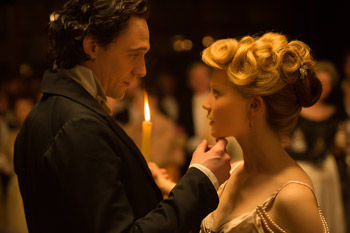
Jessica Chastain Crimson Peak
Cast: Jessica Chastain, Charlie Hunnam
Director: Guillermo del Toro
Genre: Horror
Synopsis: When her heart is stolen by a seductive stranger, a young woman is swept away to a house atop a mountain of blood-red clay: a place filled with secrets that will haunt her forever. Between desire and darkness, between mystery and madness, lies the truth behind Crimson Peak.
From the imagination of director Guillermo del Toro comes a gothic romance starring Tom Hiddleston, Jessica Chastain, Mia Wasikowska and Charlie Hunnam.
Foreword
'Welcome to Crimson Peak.
'This movie is my attempt to harken back to a classic, old-fashioned, grand Hollywood production in the Gothic romance genre. For a while, in the Golden Era of cinema, movies like Dragonwyck, Rebecca, Jane Eyre and Great Expectations were produced but then decayed into oblivion in the '50s, '60s and '70s. In fact, it's been about 30 years since someone has made a Gothic romance on this scale, and I am proud to welcome it back.
'This is a genre that was important at the end of the 18th century as a romantic reaction to the Age of Reason. It marries things that are seemingly dissimilar: heightened melodrama layered with a lot of darkness and the Gothic atmosphere of a dark fairy tale that is both creepy and eerie. It combines these elements to produce a unique flavor.
'Crimson Peak is designed to be gorgeous and beautiful, not only as eye candy but as eye protein. The movie tells you the story of who the characters are through their surroundings and the sets, which are also a reflection of their inner psychology. As well, the thematic elements of Crimson Peak come alive through the gorgeous wardrobe. Truly, the painterly beauty of this film makes it one of my favorites I've ever created.
'I hope you enjoy."
"Guillermo del Toro
Crimson Peak
Release Date: October 15th, 2015
About The Production
Ghosts of the Past: The Story of Crimson Peak
Young Edith Cushing (Wasikowska) is an aspiring author living with her father, Sir Carter Cushing (Jim Beaver of TV's Supernatural, Deadwood), in Buffalo, New York, at the dawn of the 20th century. She has grown up haunted by the loss of her mother, quite literally. Cursed with the power to communicate with the souls of the dead, Edith receives a mysterious warning from beyond the grave: 'Beware of Crimson Peak."
An outsider in high society thanks to her willful imagination, Edith finds herself torn between two rival suitors: her childhood companion, Dr. Alan McMichael (Hunnam), a brilliant intellect who stimulates her mind, or the irresistibly seductive Thomas Sharpe (Hiddleston), another outsider who embraces Edith for who she truly is and steals her heart.
When her father dies in mysterious circumstances, Thomas sweeps Edith away to his luxurious family estate: Allerdale Hall"a vast Gothic mansion in the remote English hills, alive with mystery and danger. Set atop a subterranean mine, the blood-red clay seeps through the snow and stains the mountainside, earning it the name 'Crimson Peak."
But Thomas and Edith are not alone. The towering Gothic house is also home to Thomas' sister, Lucille (Chastain)"a mysterious and alluring woman whose affection to Edith hides a secret agenda.
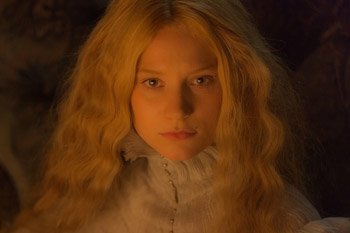 As Edith settles into her new life, Crimson Peak takes on a life of its own as she is visited by nightmarish visions and crimson ghosts"but the true monster of Crimson Peak is made of flesh and blood…
As Edith settles into her new life, Crimson Peak takes on a life of its own as she is visited by nightmarish visions and crimson ghosts"but the true monster of Crimson Peak is made of flesh and blood…
Will Edith decipher the mystery of her visions before it is too late? Will Thomas choose to save his wife or protect his family? How far will Dr. McMichael go to fight for the love of his life? And what will happen when Lucille's dark past catches up to her?
As love turns to madness and nightmare becomes reality, everyone who sets foot onto Crimson Peak is in grave danger.
But will this living deathtrap reveal the truth or seal their fate?
About The Main Characters
Edith Cushing
An aspiring author, Edith Cushing is haunted by the ghosts of her past and cursed by the visions of her future. Losing her mother to black cholera when she was only 10 had a profound effect on Edith's upbringing. She matured to the task of taking care of her aging father, all the while seeking the liberties of forward-thinking women in late Victorian society. Haunted by the memory of a warning heeded by her mother's ghost, Edith developed a fascination for the supernatural and was set on publishing a novel of Gothic fiction when her own life became a case for the story. The fair heroine of Crimson Peak is courageous and determined; she doesn't wait to be wooed or rescued. Her ability to see the spirits lurking in the shadows of Allerdale Hall leads Edith to unearth the horrors buried within its walls.
Sir Thomas Sharpe
A seductive newcomer and master manipulator, Sir Thomas Sharpe's effortless charm ignites powerful feelings he cannot control. The charming English bachelor with the title of a baronet can captivate a room with his ideas, as well as with his perfectly executed waltz. Since his father died, Sharpe has had to use his charm to propel his industrious ambitions and find funding for his invention: a clay extractor that equals the efforts of a dozen men. He masterfully disguises his intentions of marrying for wealth, but when he meets Edith his desires for her catch him off guard. He sympathizes with his young wife and feels himself resenting his sister, Lucille, for their life of melancholy and sordidness.
Lady Lucille Sharpe
The mysterious Lady Lucille Sharpe will do whatever it takes to protect her family's shocking history…but not all secrets can be buried. The introverted and mysterious Lucille grew up quarantined at Allerdale Hall. She shared what little love she knew with brother Thomas and spent her days playing the piano and collecting moths and butterflies she found around the manor. She finds herself jealous of her brother's attention for other women and protective of their familial connection. Lucille's obsession leads her to foster the darkest parts of her humanity, and her conniving schemes hold Thomas hostage to their shared malicious past.
Dr. Alan McMichael
A brilliant man of science, Dr. Alan McMichael is ruled by his heart as much as his head…and consumed by a fascination with the supernatural. Always a perfect gentleman, the well-bred ophthalmologist has been smitten with Edith since they were children. When he returns from his studies abroad to open a practice in his hometown, he finds that those feelings for his childhood love are strong as ever. Although Edith doesn't acknowledge his advances, Alan has the approval of her father and can't help but try to win her attention. The loyal suitor doesn't give up on his beloved after her father's untimely passing and seeks to expose Thomas for what he truly is. When he realizes that Edith is in danger, the suitor sets out across the ocean to her rescue.
Carter Cushing
A pioneer of American industry, Carter Cushing is an esteemed figure in Buffalo society who began his career as a steel worker and has earned everything he has with his own hands. He is a loving father to Edith and encourages her aspirations of becoming an author as best he can. When Sharpe arrives from England seeking investment from Cushing's company, he is wary of the suitor's character. When the young man expresses an interest in his daughter, Cushing doesn't hesitate to look into Sharpe's past. What he finds confirms his worst fears.
The Crimson Ghosts
The blood-red spirits of Crimson Peak are an iconic, visually distinctive supernatural spectacle. Born of the blood-red clay mines they were buried in, the ghosts themselves are clues to a larger mystery. They break the tradition of non-corporeal ghosts; they are physical beings that bend and warp the world around them. Indeed, they are living emotions"tormented souls with hollow eyes and a screaming mouth"half-glimpsed figures that let the imagination run wild. The ghosts have a message for Edith…if only she can conquer her fear and seem them for what they truly are.
Blessed with a Curse: Production Begins
Following the success of several action-packed, English-language blockbusters including Hellboy (2004), Hellboy II: The Golden Army (2008) and Pacific Rim (2013), master of terror del Toro brings to the screen a dark and imaginative Gothic romance with Crimson Peak. The filmmaker explains the premise of his latest effort in five simple words: 'Humans are the real horror."
More akin to the writer/director's The Devil's Backbone (2001), a spine-chilling, period love story veiled in horror, and the triple-Oscar®-winning Spanish language masterpiece Pan's Labyrinth (2006), his new film explores the haunting theme that love is indeed a tender trap. Just as the events of his latter production could be questioned by audiences as the product of a young girl's limitless fantasy, Crimson Peak plays with our perceptions of what is truth and what is fiction. As Edith is a burgeoning writer with a vivid imagination, could the terrifying events all be springing forth from her mind?
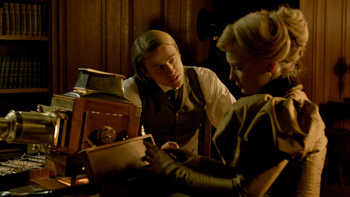 Crimson Peak is in step with the explorations of Guillermo del Toro's acclaimed Spanish-language productions, ones that gained the Mexican filmmaker international recognition. To that end, producer Callum Greene"who last partnered with del Toro on Pacific Rim"aptly refers to his new work as del Toro's 'first English-language Spanish film."
Crimson Peak is in step with the explorations of Guillermo del Toro's acclaimed Spanish-language productions, ones that gained the Mexican filmmaker international recognition. To that end, producer Callum Greene"who last partnered with del Toro on Pacific Rim"aptly refers to his new work as del Toro's 'first English-language Spanish film." Reflecting upon this project's influences, del Toro shares: 'Crimson Peak is the ghost-story equivalent of Pan's Labyrinth. It has the combination of several genres, and the fact that we are packing the punch of a traditional ghost story with the class and beauty of a classic."
For Guillermo del Toro, material exploring this genre can have ghosts and crumbling castles and 'it can have the trappings of a horror film" but intricately seeded is a classical love story in which a central 'virginal character who is discovering a secret, a treasure, a dark past…emerges somewhat transformed." And in spite of the dark turns the love story takes, the budding romance between Thomas and Edith has a lyrical quality. Still, if love is a form of madness, all of the key players in their story fall victim to it.
Crimson Peak is, according to del Toro, 'the darkest of fairytales," and the classic recipe includes a character on a journey to adulthood. 'You can find it in -Alice in Wonderland' or in -The Snow Queen,' in works by Oscar Wilde or Hans Christian Andersen," he says. The story involves finding independence; the rite of passage takes the character on a 'journey through darkness… through geographical space, across the oceans, into the underworld."
One of Guillermo del Toro's favorite Gothic romance novels is a lesser known read"'Uncle Silas," by 19th century author Joseph Sheridan Le Fanu, which encompasses all the wickedness, horror and emotion of the genre. 'This movie is extremely close to -Uncle Silas' in my heart," he states.
In keeping with personalizing his tale, Guillermo del Toro filled his story with many of his signature elements. Some, such as the moths and the butterflies, were inspired by his childhood fascinations and the fact that they come to represent Lucille and Edith. Others have become staples in his storytelling: the notion of choice, the nature of love, mechanical toys made of gears and wind-up mechanisms, the protagonist's closeness to her father, and an underground lair or cave-like setting that is used to hide deep secrets or emotions.
What attracts Guillermo del Toro to bring terror into his work is 'using ghosts to eliminate human antidotes, to illuminate the story in a human way." He took the classic Gothic romance and infused it further with his imaginative approach by building a unique haunted mansion that became the mortar of the mystery. Here, fear lives within the walls.
This mixture of psychological and physical horror greatly appealed to Legendary, with whom Guillermo del Toro has had a relationship since early discussions on Pacific Rim. The studio felt his latest work would dovetail with its mission to create credible, mythic universes. Legendary's Thomas Tull and Jon Jashni would join Guillermo del Toro and Greene to produce Crimson Peak. For Legendary CEO Tull, the opportunity to work with Guillermo del Toro once again was one he eagerly approached. He offers: 'Regardless of the genre, Guillermo del Toro brings a level of intelligence and sophistication to every one of his films. When he described to us what he hoped to accomplish with Crimson Peak, we could fully envision the journey he was taking us on. That said, the result of that vision far surpassed even our wildest dreams."
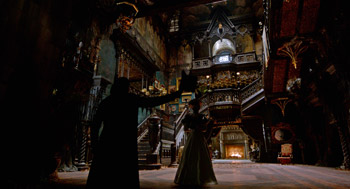 Jon Jashni has long been moved by how Guillermo del Toro is able to communicate to global audiences through his themes. 'Whether it is creating a Spanish-language classic with Pan's Labyrinth or, say, speaking to Chinese audiences through Pacific Rim, Guillermo understands the language of film," he says. 'Moviegoers feel the passion he has for his characters and stories, and they respond to his work on a deeply personal level."
Jon Jashni has long been moved by how Guillermo del Toro is able to communicate to global audiences through his themes. 'Whether it is creating a Spanish-language classic with Pan's Labyrinth or, say, speaking to Chinese audiences through Pacific Rim, Guillermo understands the language of film," he says. 'Moviegoers feel the passion he has for his characters and stories, and they respond to his work on a deeply personal level." For executive producer Jillian Share, it was the story's juxtaposition of the end of the Victorian era with the dawn of a new century that offered such narrative possibilities. 'Guillermo del Toro sets these events in such exquisite period settings, while simultaneously exploring a very contemporary theme of women finding their place and their voice in this world," she notes. 'And although their motives are quite different, Lucille is just as brilliant and determined as Edith; they're both headstrong and forward thinkers."
Love Triangles: Casting the Film
Guillermo del Toro always begins his casting process with a shortlist of actors with whom he wants to work. Fortunately for Crimson Peak, Charlie Hunnam, Jim Beaver and Jessica Chastain were on the top of that list. In fact, Guillermo del Toro had planted a seed for future collaboration with Charlie Hunnam while they were still working on Pacific Rim.
Shortly after they wrapped Pacific Rim, Charlie Hunnam received an email from the director asking him to look over the script and consider the role of Dr. McMichael, one of 20th century Buffalo's most dashing young bachelors. Charlie Hunnam was flattered to be considered for the role of the young physician smitten by Edith. The character was decidedly different from many of the characters he had played in the past: antihero types.
He recalls thinking that it was a nice surprise to be considered for a character who is 'more thoughtful and quiet, a sensitive and smart guy." Guillermo del Toro described Dr. McMichael to him as a modern character, the exact opposite of the old-fashioned Sir Thomas Sharpe. Charlie Hunnam offers that Guillermo del Toro requested that he remain true to himself. In fact, from the moment that Hunnam got out of bed, went through makeup and stepped onto set, the director asked him to maintain his energy, his spirit, his movement just as they were.
Charlie Hunnam appreciated that the production was such a narrative-driven one, and quite enjoyed that del Toro was getting back to his earlier roots. He reflects: 'Crimson Peak is similar to the vein of Pan's Labyrinth, Cronos and The Devil's Backbone"all the great work that Guillermo del Toro has done in Spanish."
Jim Beaver was thrilled when he got the call to join Guillermo del Toro's latest production. The role of Carter Cushing was also a departure from his typical casting; he felt he'd become cornered as 'rural gruff, but lovable" in his television roles. Guillermo del Toro gave Jim Beaver the opportunity to clean up and play a businessman in a period story"a strong, respectable character from a different strata of society.
Jim Beaver admits that he's not a big fan of contemporary horror movies and welcomed the chance to work on a film that makes the audience question the very things they trust in the real world. The actor offers that Guillermo del Toro brings sophistication to his work: 'His use of character and narrative build a deeply unsettling, rich terror. He sees the heart of darkness within human beings. This movie is not just a thrill ride…and that makes for a much more rewarding project to have worked on."
For the female leads, the director wanted two actresses who mirrored one another as light and darkness, butterfly and moth. Both the protagonist and antagonist are strong women fighting for survival and ultimately love. Jessica Chastain and Mia Wasikowska fit the roles perfectly. Guillermo del Toro had met Jessica Chastain while producing the supernatural thriller Mama, in which she played the lead role. In a turn of events, Jessica Chastain actually wanted another part instead. The only role for her was that of the enigmatic Lady Lucille Sharpe.
The actress has risen to stardom playing a wide range of characters, no matter how challenging the role, and her commitment has not gone unnoticed. Greene recalls seeing Jessica Chastain in the first rehearsal for Crimson Peak. Says the producer: 'She added something to that scene that caught us all by surprise and showed immediately her desire to envelop this character 100 percent."
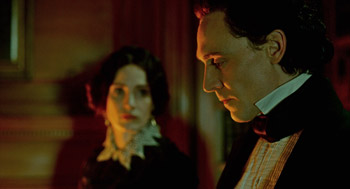 Jessica Chastain fell in love with her character, despite Lucille's 'bad qualities." She sees her as a woman who 'does everything she does for love. She's very simple in that way." She plays the piano, loves to read, loves her brother and prefers the solitude of her home because 'in her history, she's been hurt."
Jessica Chastain fell in love with her character, despite Lucille's 'bad qualities." She sees her as a woman who 'does everything she does for love. She's very simple in that way." She plays the piano, loves to read, loves her brother and prefers the solitude of her home because 'in her history, she's been hurt." As Lady Sharpe is shrouded in mystery to the audience, Guillermo del Toro provided the actress with an in-depth character biography, which Jessica Chastain used in preparing herself. Having del Toro craft the character gave the performer and the director a shared history. She says: 'When I made choices on set, he saw why I was making the choice because he knows Lucille's history."
They shared an understanding of the character's actions and influences, and Lucille's greatest motivation was love. Says Jessica Chastain: 'Hate and anger come from love; every emotion has its equal parts magnified. Guillermo del Toro creates that balance so you never feel like you're playing an empty emotion. You never feel like you're just in a ghost story. You feel like you're telling a story about real people."
Crimson Peak is confidently carried by the inquisitive naïveté of its protagonist Edith Cushing, played by Polish-Australian actress Mia Wasikowska, whose breakthrough role came in Tim Burton's Alice in Wonderland. The daughter of a self-made American industrialist Carter Cushing, Edith is a strong-minded, independent woman of the times who lost her mother at a young age. Unlike the society girls in her circle of peers whose frivolous interests include the latest fashions and getting the attention of the most eligible bachelors in Buffalo, Edith's ambition leads her to explore the supernatural world through writing.
Mia Wasikowska was intrigued to work on another film with horror influences, admitting that she has been dismissive of the genre in the past. However working with Guillermo del Toro has been a prized learning experience for the actress. She recalls the director referencing Frankenstein in the early stages of filming: 'Fear is how we learn about who we are." Just as he did for Jessica Chastain as Lucille, Guillermo del Toro crafted an eight-page biography for Mia Wasikowska. She offers: 'It was incredibly in-depth. There were things about her Edith's upbringing, her relationship to her parents and different smells that she liked."
To her credit, Mia Wasikowska doesn't see Edith as a heroine, nor that there is a definitive 'good guy or bad guy" in the film. 'All the characters are relatively ambiguous, enough that you could see them in either way…all of them doing what's necessary to survive," she muses. Survival for Edith entailed a fall in the mansion set, the most terrifying and exhilarating stunt that Wasikowska has ever performed. 'It goes against all your instincts," she laughs. But after a few rehearsals, the actress couldn't wait to do it again.
As he was by Jessica Chastain, Greene was stunned by Mia Wasikowska's ability to portray Edith with just the right amount of naivety and strength. He commends: 'Mia Wasikowska's very free; there's no ego there." Observing her ability to deal with the complexity of emotions that her character demanded, he states: 'She was tremendous."
Edith's true love is Sir Thomas Sharpe, a refined young bachelor from England who comes to America seeking investments for his new invention, a machine that aids in the mining of clay. Sharpe quickly falls for Edith, and the young woman is smitten by the dark foreigner who shows an interest in her writing and fills her imagination with romantic notions of a place far away from home.
Cast as Thomas Sharpe was actor Tom Hiddleston. The performer, who is well known for his deliciously evil work as Loki in Marvel's universe, got a phone call from del Toro in the summer 2013 asking him to read the script. He was seduced by the sophistication of the writing and admits that he loved the 'moral ambiguity" of his character. In addition, Tom Hiddleston was thrilled at the opportunity to work alongside his longtime friend jessica Chastain. And considering that he had previously worked with Wasikowska on Jim Jarmusch's Only Lovers Left Alive, the performer felt the project would be a great fit.
Tom Hiddleston had long been a fan of Guillermo del Toro as well. The actor states: 'Guillermo is probably, if not definitely, the primary interpreter of Gothic romance in contemporary cinema. He has the capacity to make stories about the supernatural intensely emotional and accessible."
Tom Hiddleston wanted his character to feel 'hugely emotional and redemptive" for the audience to feel his emotional journey so that the film would unfold from a horror to a drama and a romance, undoubtedly Guillermo del Toro's own intent. As he did with Jessica Chastain and Mia Wasikowska, Guillermo del Toro provided Tom Hiddleston with a character biography that gave the actor 'authentic flavor" for the character he was playing. The director even shared some of Sharpe's secrets, which he instructed the actor not to share with the other cast. In admiration, Tom Hiddleston affectionately refers to del Toro as 'a great Mexican bear," noting his extraordinary passion having the capacity to 'light a spark which goes around the entire crew. We'd follow him everywhere because he believes in it so deeply."
There are not just humans in this Gothic romance. The ghosts of Allerdale Hall were as real as the film's main characters; they were actors in intricately designed costumes mirroring the crimson clay of the mining pits. 'They were incredible with their movements and simply beautiful," says Jessica Chastain.
Interaction with a real human being allowed the actors to elevate their performance as they often felt genuinely terrified in their surroundings. 'I've never seen ghosts like this before; I love that you can see their human form," says Mia Wasikowska. 'I think the more human the image of a ghost, the scarier it is because we can relate to it as something that we are, or were."
As Guillermo del Toro is known to tinker with his script until he achieves perfection, Greene recalls reading a version of the screenplay for the first time several years ago. The core of it remains the same, but the producer advises that 'what changed was Guillermo del Toro's attention to the female characters." In fact, on day 52 of principal photography, the filmmaker was still adding new pages to the script, minute corrections that evolved daily based on his interactions with the actors and their interactions with one another about the characters' evolution. This custom tailoring of a project is the filmmaker's modus operandi; he guides, he listens, he absorbs, 'and by that trust, they give it back," says Greene. 'It's a little known fact, but Guillermo is a magician."
Physical Horror: The Architecture of Fear
Allerdale Hall is a vast Gothic mansion that sits atop a remote English hillside, with generations of secrets buried within. Set in the middle of nowhere, surrounded by a bleak open landscape of barren earth and pure white snow, Allerdale Hall is perched above a profitable red clay deposit, which earns it the name 'Crimson Peak."
Every room holds a new mystery"from the subterranean mines to the forbidden attic"from the library of secrets to the cage-like elevator with a mind of its own. The house is designed like a butterfly killing jar…designed to allure and trap the beautiful and the innocent. It also hides the Sharpe family's darkest secrets and reveals unspeakable truths. Indeed, who will make it out alive?
The haunted house that is Allerdale Hall is perhaps the most important element of the film and acts as a vessel for the storyline. It is the story's most fearful character, oozing red clay from beneath the earth. Guillermo del Toro is an artist who visualizes before he builds, so it's no surprise that once he had assembled a team to make his visions a reality, the house and all of the elements it embodies already existed in his mind. The house was a character with its own biography and history.
No existing structure could satisfy Guillermo del Toro's vivid imagination. Where other Hollywood productions would have turned to computer technology, creating an edifice filled with fears and terrors, the director decided to build a magnificent set of days gone by. Building the haunted house required teams of set designers, builders and decorators to work in tandem for nearly six months in order for everything to be completed in time for the shoot. Naturally, designing to facilitate the work of cinematographer Dan Lausten was a key part of every conversation.
Every production begins with a given set of constraints, schedules, budgets and approvals. For art director Brandt Gordon, those pressures were a daily negotiation in order to make all the visual elements of the film a reality. The collaboration began at script level. From the very first read, he began working alongside production designer Thomas Sanders, set decorator Shane Vieau and costume designer Kate Hawley. Together, the team would research, compile design elements, palettes, textures and shapes and present them to Guillermo del Toro for review. The director instantly filtered what worked and what didn't. From Guillermo del Toro's mandates of 'We want square shapes in US and round shapes in U.K.," each decision from the director helped to inform the team's design choices and create the two distinctly different worlds that del Toro had envisioned.
Twelve weeks before preproduction began, production designer Sanders arrived in Toronto with a 20-foot trailer, ready to create a shop and build models. Sanders' process is unique; no one in the industry builds models of his scope. His method, what Gordon refers to as '3D sketching," was instrumental in determining all the features of the final set design"including proportions, wild walls, layouts, colors and finishes. It was not a traditional art department in the beginning, but to accommodate Sanders' process Gordon hired a support team"key scenic artists Cameron Brooke and Robert Brooke"as the model building began.
Cameron Brooke was ecstatic to work with Sanders because of his method of meticulously planning out the model, accounting for each angle that the camera would use, the scale of each wall and corridor, as well as the details in the finishes. Brooke explains: 'To create the illusion of an extremely large mansion, Tom worked out sightlines to fool the eye, fool the audience into thinking that this is an enormous space."
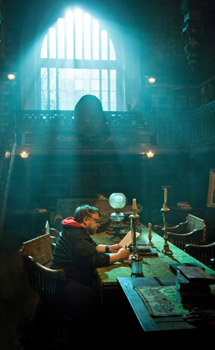 Working on this level allowed the team to smooth out design problems and develop concepts more efficiently. Morning meetings included illustrator Guy Davis, who would make 2D sketches for the model building team. Guillermo del Toro sifted through all the ideas on the table to create a design palette that Gordon describes as neo-Gothic, with Tudor influences and neo-Renaissance influences. As the model building progressed, the director was also able to figure out camera angles and plan his shots, well before the set ever existed. Brooke was instructed by Sanders to add magnets to pieces of the model so that it could be easily taken apart and put back together. Initially, Guillermo del Toro was a little hesitant about the maquette, but quickly realized that Sanders created a working sketch that could change with the director's needs and demands.
Working on this level allowed the team to smooth out design problems and develop concepts more efficiently. Morning meetings included illustrator Guy Davis, who would make 2D sketches for the model building team. Guillermo del Toro sifted through all the ideas on the table to create a design palette that Gordon describes as neo-Gothic, with Tudor influences and neo-Renaissance influences. As the model building progressed, the director was also able to figure out camera angles and plan his shots, well before the set ever existed. Brooke was instructed by Sanders to add magnets to pieces of the model so that it could be easily taken apart and put back together. Initially, Guillermo del Toro was a little hesitant about the maquette, but quickly realized that Sanders created a working sketch that could change with the director's needs and demands. Guillermo del Toro was instrumental in informing the feel and palette of the house, providing the team with references to previous films he had worked on, as well as numerous books and other source materials. For the clay mine, says Gordon, 'He brought out a Japanese book with imagery of pools of rusty water; there was a teal-green color to the walls." Del Toro had specific ideas about the characters painted on the walls, what the columns should look like, how aged the décor should look and how to give the sense that it was once a very elaborate and expensive place.
A team of sculptors created clay models of architectural pieces from the period that would be impractical (and virtually impossible) to purchase. The clay models would then be made into molds, and the pieces were reproduced in the quantities needed. The full-scale production team was upwards of 120 people and, at any one time, approximately 60 were working in the mold-making department"from the sculptors and plasterers to the people making the silicone to those creating the jackets.
Allerdale Hall was no ordinary set; it was a house complete with ceilings and hallways connecting all the rooms, the equivalent of 10 sets in one. The idea was that the seamless set would allow the camera to move from one part of the house to the next without the need for digitally stitching scenes in postproduction.
The only room independent of the house set was the bedroom: 'That was the breaking point," recalls Gordon. All the elements of this colossal set had to be ready at the same time. 'We needed part of the exterior going into the foyer, going into the grand stairwell, into the kitchen, into the coal room, into the scullery, into the elevator, into the great hall and upstairs. Remember, it's a 70-foot corridor upstairs and up to the third floor attic."
The performers were gobsmacked when they stepped foot on set. 'When I first walked onto the set I was completely blown away," says Jessica Chastain. 'I've never seen anything like it before."
The scale of the set was something extraordinarily rare in modern moviemaking. 'It's plain and simple the biggest set I've ever been on in my life," agrees Hiddleston. The actor credits del Toro with creating the perfect 'crumbling relic of a building that houses the supernatural. It has demons and secrets the same way that a human being does."
To allow for larger spans and give Guillermo del Toro's crew more flexibility to decide where the massive walls should be as things developed, large parts of the set were built of steel rather than traditional wood. In fact, all the fireplaces on the set were functioning, so everything had to be fireproofed. The floors had a very specific wood look, but were made of a very strong type of concrete to stand up to crew traffic without being damaged.
The design elements also included moths, which the director wanted to incorporate throughout the house. According to the writer/director, 'this house has to be alive." Sanders suggested that the wall surfaces were the skin of the house, and the cracks were revealing the flesh. 'Yes, the house will be oozing its bodily fluids," del Toro laughs.
Gordon's team was also involved in the practical special effects, making clay bleed from the floor and walls. They determined the right material to achieve the viscosity, the color and the look. The effects contributed to character of the house, an edifice that was living, breathing, bleeding.
Here the model served as a map to the full-scale set. Brooke plastered and aged the model to determine where the actual patches would go. Covering the surfaces of the set is expensive and time consuming and, as Brooke says, 'one has to deal with a very thick build up to give the undulations in an aged wall that has been oozing clay for decades. There's a great amount of satisfaction to seeing something that you worked on transformed into a full scale set. It's a scenic art dream."
Finding practical locations was another logistical challenge that required not only period appropriate interiors, but also the flexibility to transform them to suit the style of the film. One of these was Victoria College in Toronto. Gordon had night crews working 14-hour shifts for weeks to prep and paint the locations. Once the school opened again they could only return on the weekends. In other cases the difficulties were created by nature.
In mid-February, when the team began to work outdoors to set up the main façade of Allerdale Hall, the Canadian ground was completely frozen. When shooting began in April, everything began to thaw. 'We experienced the whole freeze-thaw cycle"being up to our knees in mud as we were getting the final elements ready for the shoot," says Gordon. It then took almost three weeks to transport everything back to the stage, and another week to dress it with white and red snow; to accomplish, the scenic team used paraffin wax.
Gothic Sensibilities: Art Direction
All involved with the production learned that del Toro has an encyclopedic knowledge of the Victorian Era. To build on the classic visuals, set decorator Vieau sparred with the director on each element of the décor. The filmmaker wanted 'Bradbury & Bradbury wallpaper." Vieau would go on the hunt for it. He was able to source period furniture and décor without having to go to England, as was originally planned. In L.A., he found a 17th-century tapestry that was used in Allerdale Hall, a piece that really anchored the opulence of the great mansion. But the discussion really began with color and texture; 'color was the most important thing in the film for me," says Vieau.
According to Guillermo del Toro, 'the way the film was art directed was by creating two completely different chapters. The first part happens in America, and America is tobacco, gold and rich sepias; it's the color of progress and life. When we go to Crimson Peak, everything becomes cold and dark. It becomes really spooky."
The filmmaker loves teal greens inspired by foliage; his color choices create mood, setting"a mystical world of his imagination. Much of Lucille's wardrobe was about 'blending into the architecture and that was the footprint for how we approached color," says Vieau. The Sharpe master bedroom was filled with deep textured velvets, the drapes in rich silks. The great hall was decorated with cotton ribbons on the bookcases to add gold highlights; the sofa was draped in deep green silk; the furniture was reupholstered in tapestries.
Fittingly, the word 'Fear" was layered into the house, throughout the design elements. The wallpapers were custom designed to incorporate the moth and butterfly motifs that del Toro wanted repeated in the floors and hallways"symbolizing Lucille's fascination with trapping things, people, designing fear into the fabric of the house. 'Fear" was inscribed into the chair, in the mantle"subliminally brewing dread, anxiety and terror, as any authentic haunted house should.
Beware of Crimson Red: Costumes of the Film
Costume designer Kate Hawley describes Crimson Peak as a dreamy, theatrical Victorian film rather than one resembling reality. When the project began, del Toro declared to Hawley: 'We're going to build the costumes, and we're going to couture the architecture." She and her team created a wardrobe to mirror del Toro's sculptural visions. Indeed, the designer notes: 'His work is about layering…there are elements of a fairytale, there is history, there is poetry."
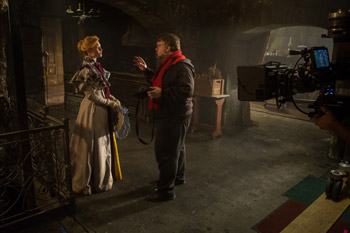 In the early stages of the design process Hawley recalls the discussions about mood and color: the wardrobes in America represent summer, gold and tobacco, growth and progress; while England is winter, withering foliage, deep blues and teal greens. To add to the challenge, she was to avoid white, black and red for the Buffalo wardrobes"forcing her to work with a palette of cream, charcoal and burnt orange. There are no true highlights or shadows in those scenes, she notes; whereas, in Allerdale, the heavy dark fabrics weighted the characters in the depth of the Gothic romance.
In the early stages of the design process Hawley recalls the discussions about mood and color: the wardrobes in America represent summer, gold and tobacco, growth and progress; while England is winter, withering foliage, deep blues and teal greens. To add to the challenge, she was to avoid white, black and red for the Buffalo wardrobes"forcing her to work with a palette of cream, charcoal and burnt orange. There are no true highlights or shadows in those scenes, she notes; whereas, in Allerdale, the heavy dark fabrics weighted the characters in the depth of the Gothic romance. Hawley's team became so attached to each creation they began naming the costumes. She sums: 'All of the dresses have their moods." The 'Buffalo Bookworm" is Edith's 'Mary Shelly-romanticized-writer" ensemble, which is masculine in the tailoring. The 'Heartbreak Dress," based on a Klimt painting, is a delicate and fragile gown with a small flower with a heart in the center. 'It was how we found our language in terms of decoration, adding to support the story," says Hawley. Flowers were a theme in Edith's costumes conveying 'richness and fertility… her generosity in spirit." Her bride's dress was decorated with a string of violets, a Victorian symbol of memory and morning.
Lucille's dresses were barren with motifs of withered leaves that were full of catastrophe, starvation and barrenness. The embroidery on Lucille's wardrobe mirrored the details in the architecture of the house. 'So she was wearing the house in many ways," says del Toro. The tailoring of her wardrobe was decidedly different as well. Hawley's designs accentuated Lucille's thinness; the dresses were very fitted and slim 'so you could feel the bones through the clothes." Her frail silhouette resembled the long, narrow shapes of the house.
The costume department worked closely with del Toro to explore and help each of the actors to identify the demands of each character. The director wanted the costumes to play with scale and shape, so the choice of textiles was informed by his ideas. 'We wanted to echo the architecture," says Hawley, 'so we tried to make the clothes very sculptural." When Edith begins to fade at Allerdale, she becomes frail 'more transparent, like a chrysalis" and that idea translates to her nightdress.
The layered delicate silks of the costume were intended to aid Wasikowska's performance in its movement. For their part, Lucille and Thomas were like chameleons in their world. Against the blues and shadows of the house Lucille blended into the walls like a moth. To further accentuate the director's motif, the wardrobe team spent hours hand-stitching fine fabrics by using antiquated pleating techniques; this made the outfits flow and flutter like the wings of Guillermo del Toro's favorite insects.
Given the challenge of working with a restrictive palette for the main cast, when the color red was finally introduced for one of the spirit's dresses, Hawley remembers feeling the intensity: 'It was so theatrical, such strong imagery." Unlike any ghosts we've seen before, del Toro's spirits feet real, like eerie version of their former selves rather than ethereal phantoms. Discussions between Hawley and del Toro often ended in the conclusive idea 'horror has to be a beautiful thing."
Crimson Peak
Release Date: October 15th, 2015
Have You Seen This?
MORE






